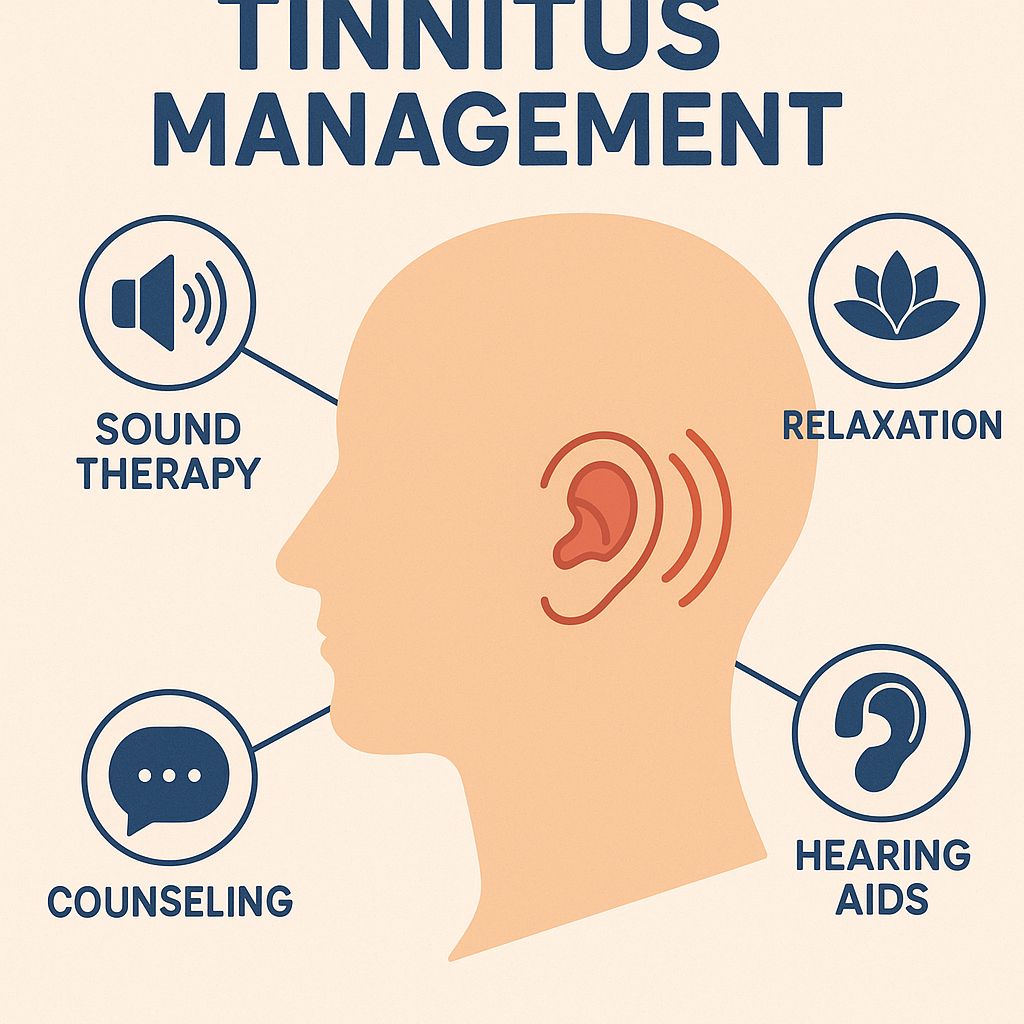Key Takeaways
- ReSound Relief offers extensive sound therapy customization with layered soundscapes, while Oto focuses on a structured 8-week CBT program for tinnitus habituation
- Oto provides direct access to tinnitus coaches within the app, creating a more personalized approach to tinnitus management
- Sound therapy (ReSound Relief) and cognitive behavioral therapy (Oto) represent two scientifically-backed approaches to tinnitus management with complementary benefits
- ReSound Relief includes sophisticated tracking tools to identify tinnitus triggers, while Oto excels in guided habituation exercises
- Both apps can be used together for a comprehensive approach to tinnitus management, targeting both immediate relief and long-term habituation
The constant ringing, buzzing, or whistling of tinnitus can feel like an inescapable prison. If you’re among the millions struggling with these phantom sounds, you know how desperately you’d try almost anything for relief. Smartphone apps have emerged as accessible tools in tinnitus management, offering evidence-based approaches right in your pocket. In this comprehensive comparison, we’ll examine two leading options: ReSound Relief and Oto, helping you determine which might better address your specific tinnitus needs.
Tinnitus management apps like Oto provide structured therapy programs based on proven cognitive behavioral therapy techniques to help patients develop healthier responses to their tinnitus symptoms. Their approach combines habituation techniques with expert coaching to address the psychological impact of persistent tinnitus. The right digital tool can make a significant difference in how you experience and manage your tinnitus on a daily basis.
Why Digital Tinnitus Management Apps Matter for Your Relief
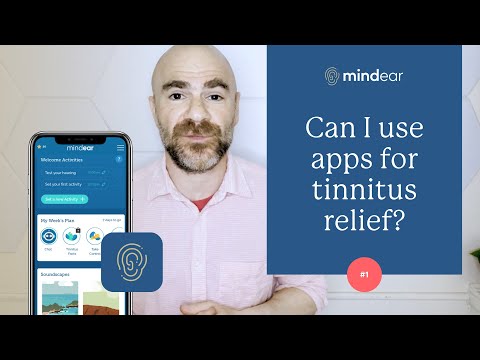
“Tinnitus relief through new app, study …” from gainesvilleaudiologist.com and used with no modifications.
Digital tinnitus management applications provide consistent, on-demand tools that traditional therapy sessions cannot. Instead of waiting for weekly appointments, you can access relief strategies whenever tinnitus flares up—whether that’s during a stressful workday or in the middle of the night. These apps employ evidence-based techniques that previously required in-person specialist visits, making effective tinnitus management more accessible to everyone regardless of location or mobility limitations.
The 24/7 availability of these digital solutions addresses one of tinnitus’s most challenging aspects: its unpredictability. When tinnitus suddenly intensifies during a business meeting or while trying to sleep, having immediate access to coping tools can mean the difference between spiraling anxiety and maintained composure. Additionally, these apps track your tinnitus patterns over time, providing valuable data that helps identify triggers and measure improvement—something difficult to accomplish with traditional management approaches.
The interactive nature of digital tools also improves treatment adherence. Research consistently shows that patients are more likely to follow through with therapy when it’s engaging and convenient. By gamifying elements of tinnitus management and providing immediate feedback, apps like ReSound Relief and Oto help users maintain consistent practice of therapeutic techniques, which is essential for long-term habituation and relief.
ReSound Relief App: Features and Benefits
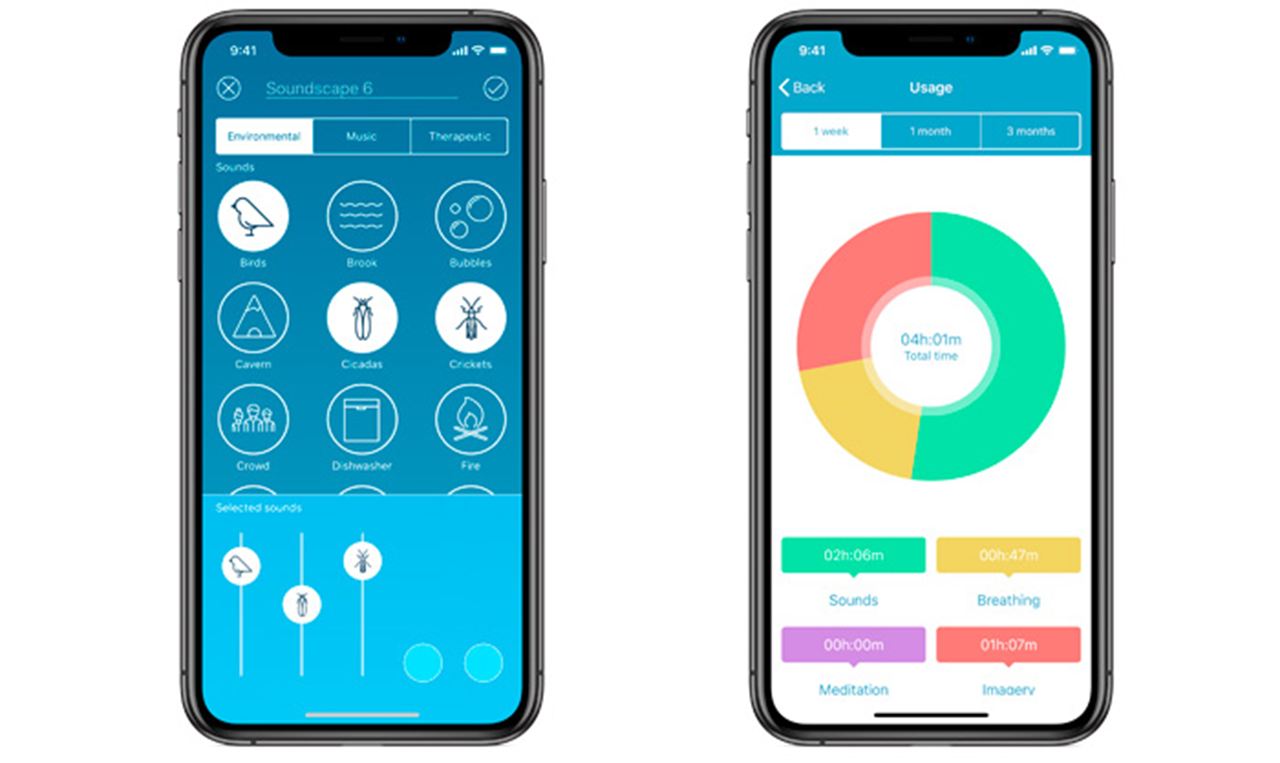
“ReSound Relief App …” from www.resound.com and used with no modifications.
ReSound Relief stands out for its comprehensive sound therapy approach, offering one of the most extensive libraries of customizable soundscapes specifically engineered for tinnitus relief. The app allows users to create personalized sound environments by mixing and layering different audio elements—from nature sounds to white noise—at varying volumes. This customization is crucial because tinnitus presents differently for each person, and finding the right masking or distraction sounds often requires experimentation.
Sound Therapy Options and Customization
ReSound Relief’s sound therapy library offers remarkable depth with over 30 adjustable sound elements that can be mixed into countless combinations. Users can layer ocean waves with light rainfall, add distant bird calls, or incorporate specific frequency-matched white noise designed to mask particular tinnitus tones. The app includes environmental sounds, specialized white/pink/brown noise variations, and musical elements all designed to provide relief through sound enrichment techniques.
What truly differentiates ReSound’s approach is the ability to create sound therapy “recipes” tailored to different situations. You might develop one combination for sleeping, another for working, and a third for high-stress situations when tinnitus typically intensifies. The app saves these customized soundscapes, allowing quick access when needed most. Additionally, ReSound Relief includes a unique sound matching tool that helps identify the specific frequency of your tinnitus, then suggests optimal sound therapy elements that target those frequencies.
Relaxation Exercises and Guided Meditation
Beyond sound therapy, ReSound Relief incorporates guided breathing exercises and progressive muscle relaxation techniques specifically designed for tinnitus sufferers. These sessions target the anxiety-tinnitus cycle, where stress amplifies tinnitus perception, which in turn increases stress. The guided relaxation modules range from quick 2-minute breathing exercises for immediate calming to comprehensive 20-minute deep relaxation sessions.
The meditation content focuses on mindfulness techniques that help users develop a healthier relationship with their tinnitus. Rather than fighting against the sound, these exercises guide users toward accepting and observing tinnitus without emotional attachment. This approach aligns with acceptance and commitment therapy principles that have shown promise in tinnitus management research.
Importantly, ReSound’s relaxation content was developed in collaboration with audiologists and psychologists specializing in tinnitus management. The exercises incorporate specific language and techniques that address tinnitus-related distress, rather than generic relaxation content that might not address the unique challenges of phantom sound perception.
Tracking and Monitoring Tools
The ReSound Relief app includes sophisticated tracking tools that help identify patterns and triggers in your tinnitus experience. Users can log tinnitus intensity, emotional state, activities, and environmental factors, creating a comprehensive dataset that reveals connections between lifestyle factors and symptom severity. The app generates visual reports showing trends over time, helping users recognize when their tinnitus tends to worsen and what factors might contribute to relief.
User Interface and Navigation Experience
ReSound Relief features a clean, intuitive interface with straightforward navigation that prioritizes quick access to relief tools. The home screen presents your most-used sound combinations and relaxation exercises, allowing for one-tap access during tinnitus flare-ups. The color scheme employs calming blues and greens specifically selected to avoid visual stimulation that might exacerbate tinnitus symptoms for visually-sensitive users. For those interested in how sound can aid tinnitus, learn more about tinnitus masking hearing aids and their benefits.
Navigation follows a logical flow, with primary functions accessible via a bottom menu bar and secondary options nested within relevant sections. This hierarchy ensures that users can quickly access sound therapy during moments of distress without navigating through multiple menus. The app also includes accessibility features like adjustable text size and compatibility with screen readers, making it usable for those with visual impairments alongside tinnitus.
Oto App: CBT-Based Approach to Tinnitus
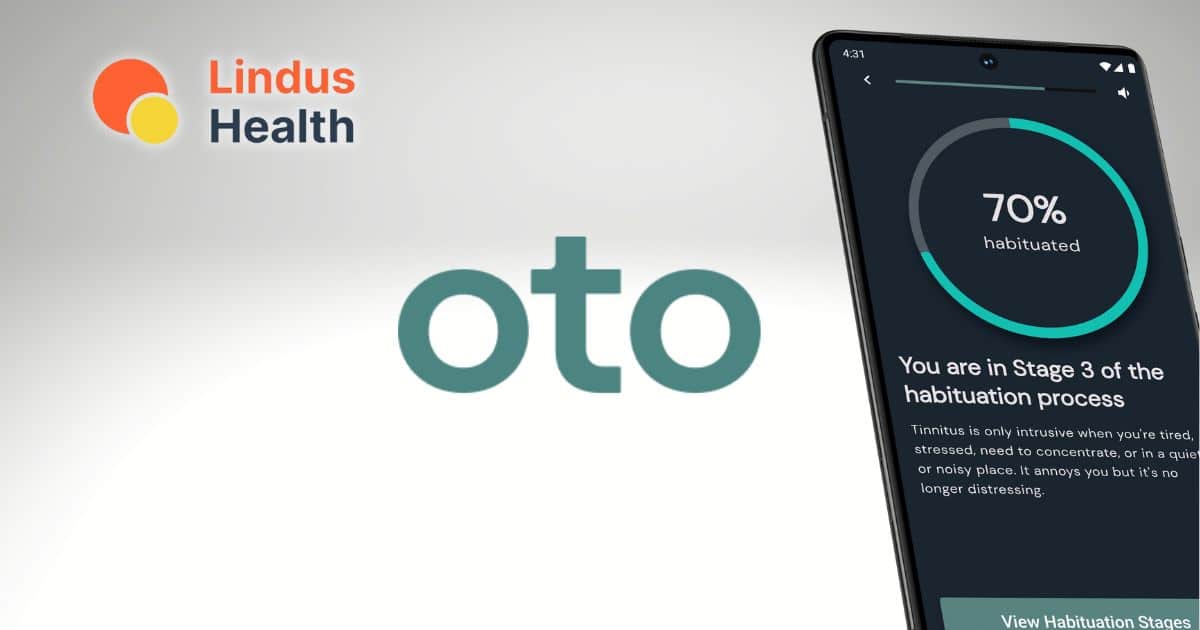
“Lindus Health and Oto Launch Remote …” from hearinghealthmatters.org and used with no modifications.
Oto takes a fundamentally different approach to tinnitus management by focusing primarily on cognitive behavioral therapy (CBT) and habituation techniques rather than sound masking. Developed by audiologists, ENT specialists, and clinical psychologists, Oto delivers a structured 8-week program designed to change how your brain processes and responds to tinnitus. This approach addresses the neurological and psychological components of tinnitus rather than merely providing temporary relief.
Cognitive Behavioral Therapy Framework
Oto’s CBT framework represents a significant advancement in digital tinnitus management, offering systematic therapy previously available only through specialist appointments. The app breaks down complex therapeutic concepts into daily 10-minute audio sessions that progressively build coping skills. These sessions target catastrophic thinking patterns common among tinnitus sufferers, helping users recognize and restructure negative thought cycles that amplify tinnitus distress.
Each week introduces new cognitive techniques specifically tailored to tinnitus management. Early modules focus on education about the neurological mechanisms behind tinnitus and challenging misconceptions that often increase anxiety. Later sessions introduce thought restructuring exercises, attention control techniques, and specific cognitive strategies for managing tinnitus-related sleep disruption, concentration problems, and emotional responses.
What distinguishes Oto’s approach is its foundation in tinnitus-specific CBT research rather than generic mindfulness content. The program incorporates techniques from specialized tinnitus treatment protocols developed at major audiology research centers, adapted specifically for self-guided digital delivery. This specialized focus addresses the unique psychological challenges of tinnitus that general wellness apps typically miss.
Habituation Techniques and Daily Exercises
Habituation—teaching your brain to stop noticing tinnitus—forms the cornerstone of Oto’s approach. The app provides a progressive series of attention training exercises that gradually help reduce tinnitus’s prominence in your consciousness. These exercises begin with brief periods of focused attention on your tinnitus, combined with relaxation techniques to reduce the emotional response. Over time, exposure duration increases while teaching neural desensitization methods.
Each day features different habituation activities designed to be practiced in various environments. Some exercises incorporate background environments to practice tinnitus management in simulated real-world settings like restaurants or offices. Others focus on specific challenging situations like preparing for sleep or concentrating during work. The incremental nature of these exercises builds habituation capabilities gradually, preventing the overwhelm that can occur with less structured approaches.
Oto also includes specialized techniques for tinnitus spikes—those periods when tinnitus suddenly intensifies. These emergency tools combine rapid breathing regulation, cognitive defusion techniques, and grounding exercises specifically designed to interrupt the panic-tinnitus feedback loop that often accompanies sudden intensity increases.
Direct Access to Tinnitus Coaches
One of Oto’s most valuable features is its in-app access to tinnitus specialists who provide personalized guidance. Unlike most digital health apps that operate without human support, Oto offers messaging-based communication with audiologists and CBT specialists trained specifically in tinnitus management. Users can ask questions about their specific symptoms, receive advice on adapting exercises to their circumstances, and get encouragement during challenging periods.
This coaching component addresses a common limitation of digital interventions—the lack of personalization and accountability. The coaches review users’ progress data, offering tailored suggestions based on their reported experiences and adherence patterns. They can also help troubleshoot when certain techniques aren’t providing expected benefits, suggesting modifications or alternative approaches based on the latest tinnitus research.
Access to these specialists represents significant value, considering that in-person tinnitus specialist consultations often cost $150-300 per session and may require long waits for appointments. Oto makes this expertise accessible at a fraction of traditional treatment costs, with response times typically under 24 hours for non-emergency questions.
Progress Tracking and Personalization
Oto employs sophisticated tracking tools that measure more than just tinnitus intensity. The app regularly assesses psychological factors like tinnitus-related distress, sleep quality, concentration ability, and emotional well-being using validated clinical assessment instruments. This comprehensive monitoring provides a more accurate picture of progress, as successful tinnitus management often shows improvements in these areas before perceived loudness changes.
The app adapts content based on user responses and progress patterns. If sleep disturbance emerges as a primary concern, the algorithm prioritizes sleep-focused modules. If anxiety scores remain elevated while other measures improve, additional anxiety management techniques are introduced. This adaptive approach ensures that resources are directed toward each user’s most significant challenges rather than following a one-size-fits-all progression.
Scientific Evidence: How These Apps Actually Help
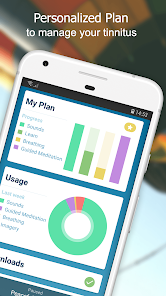
“ReSound Tinnitus Relief – Apps on …” from play.google.com and used with no modifications.
The efficacy of digital tinnitus management isn’t merely anecdotal—it’s supported by growing scientific evidence. Multiple peer-reviewed studies have demonstrated that app-based interventions can achieve results comparable to in-person therapy for many tinnitus sufferers. Research published in the International Journal of Audiology showed that consistent use of sound therapy applications led to significant reductions in tinnitus distress scores and improved quality of life measures after 8-12 weeks of regular use.
Research Supporting Sound Therapy in ReSound Relief
ReSound Relief’s sound therapy approach builds on decades of research into acoustic treatments for tinnitus. A 2019 study in the American Journal of Audiology evaluated customizable sound therapy applications including ReSound Relief, finding that participants who used the app’s personalized soundscapes for at least 2 hours daily experienced average Tinnitus Handicap Inventory score reductions of 8.2 points after 3 months. This improvement reached the threshold for “clinically significant change” in tinnitus impact. For more insights on how the app can help ease tinnitus symptoms, read about the ReSound Relief app.
Clinical Studies Behind Oto’s CBT Approach
Oto’s CBT framework is built on robust clinical evidence supporting digital cognitive behavioral therapy for tinnitus. A landmark 2021 study in JAMA Otolaryngology-Head & Neck Surgery demonstrated that internet-delivered CBT produced significant reductions in tinnitus distress comparable to face-to-face therapy. Participants using structured digital CBT programs showed a 15-point average reduction on the Tinnitus Functional Index—exceeding the threshold for “substantial clinical improvement.”
The effectiveness of Oto’s specific implementation was evaluated in a 2022 pilot study involving 67 chronic tinnitus patients. After completing the 8-week program, participants reported an average 21% reduction in tinnitus distress scores and a 34% improvement in tinnitus-related sleep difficulties. Most notably, these improvements persisted at the 6-month follow-up assessment, suggesting that the digital CBT approach creates sustainable changes in how users process and respond to their tinnitus.
Neuroimaging research further supports Oto’s methodology. Functional MRI studies have shown that CBT techniques similar to those employed by Oto reduce hyperactivity in the brain’s emotional processing centers when exposed to tinnitus sounds. This neurological evidence confirms that the app’s approach directly addresses the brain mechanisms that convert tinnitus from a neutral sound into a distressing experience.
Expert Opinions on Digital Tinnitus Management
Leading audiologists and tinnitus researchers increasingly endorse digital management tools as valuable components of tinnitus care. Dr. Richard Tyler, a prominent tinnitus researcher at the University of Iowa, notes that “well-designed apps incorporating evidence-based sound therapy and psychological approaches represent a significant advancement in accessible tinnitus care.” Similarly, the American Tinnitus Association now includes digital tools in their recommended management strategies, particularly for patients with limited access to specialized tinnitus clinics. For instance, the ReSound Relief app is highlighted for its role in providing relief to tinnitus sufferers.
Tinnitus specialists particularly value the consistent reinforcement that apps provide between clinical appointments. Dr. Jennifer Gans, audiologist and developer of the Mindfulness-Based Tinnitus Stress Reduction program, emphasizes that “daily practice is essential for tinnitus habituation, making smartphone applications ideal delivery mechanisms for maintaining therapeutic momentum.” This expert consensus suggests that digital tools like ReSound Relief and Oto serve both as standalone interventions for mild-to-moderate tinnitus and as valuable supplements to professional care for more severe cases.
Head-to-Head Comparison: Which App Performs Better?
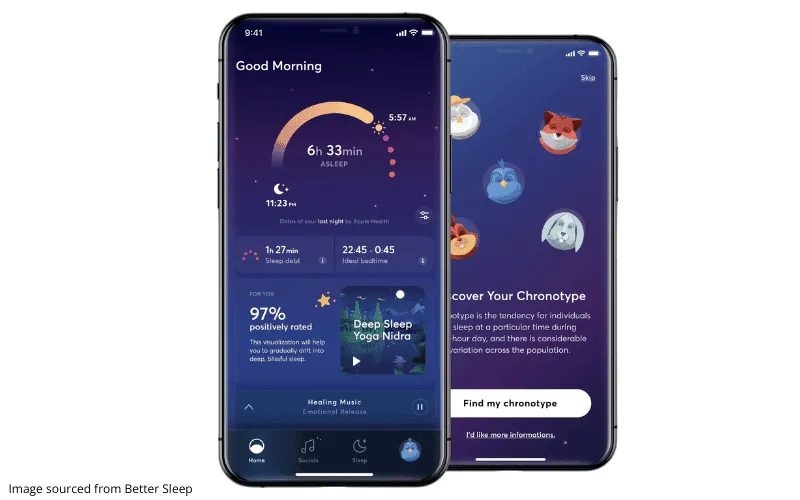
“Top Tinnitus Apps of 2025: Relief at …” from treblehealth.com and used with no modifications.
When comparing ReSound Relief and Oto directly, it becomes clear that they excel in different areas rather than one being universally superior. ReSound Relief offers unmatched sound therapy customization and excellent immediate relief tools, while Oto provides superior long-term habituation training and professional guidance. Your ideal choice depends on your specific tinnitus experience, management goals, and preferred approach.
Effectiveness for Different Tinnitus Types
ReSound Relief typically performs better for tinnitus that fluctuates significantly in tone or volume throughout the day, as its customizable sound environments can be adjusted to match changing symptoms. Users with tinnitus triggered by silence or specific acoustic environments also report excellent results, as the app’s sound therapy directly addresses these environmental factors. The sound matching feature proves particularly valuable for those with tone-specific tinnitus, allowing precise frequency targeting.
Oto shows stronger outcomes for users whose tinnitus causes significant emotional distress, sleep disruption, or concentration difficulties. Its structured CBT approach directly addresses the psychological impact that often makes tinnitus most debilitating. Patients with long-standing chronic tinnitus that hasn’t responded well to sound therapy alone frequently report substantial improvements with Oto’s habituation-focused approach. The coaching component also makes Oto more effective for complex cases requiring personalized guidance.
User Experience and Interface Quality
ReSound Relief offers a straightforward interface prioritizing quick access to sound therapy tools. Navigation is intuitive with minimal learning curve, making it immediately accessible even during high-stress tinnitus episodes. The sound mixer provides excellent visual feedback through an elegant interface that makes complex sound customization feel simple. However, some users report that the educational content feels somewhat secondary to the sound features, requiring more digging to access.
Oto presents a more structured, program-oriented interface focused on guiding users through the 8-week CBT process. The daily session format creates clear expectations and progression, with an engaging visual representation of your journey. The app excels at presenting complex psychological concepts in accessible ways through well-produced audio sessions and simple interactive exercises. Some users find the structured approach requires more commitment than ReSound’s more flexible, on-demand design. For more information on how CBT can aid tinnitus management, you can explore its role in tinnitus relief.
Personalization Capabilities
ReSound Relief excels in sound therapy personalization, offering unmatched customization of acoustic environments. Users can create virtually limitless combinations of sounds tailored to their specific tinnitus characteristics and preferences. The app also provides solid personalization in tracking features, allowing detailed logging of factors that might influence tinnitus perception. However, the therapy content itself follows a more standard progression with limited adaptation to individual needs.
Oto delivers superior personalization in therapeutic content, with the program adapting based on your reported experiences, progress metrics, and specific challenges. The coaching component adds another personalization layer, providing human-guided adjustments to your program. While Oto offers fewer sound therapy customization options, its CBT exercises adapt more intelligently to your particular psychological response patterns and tinnitus triggers, creating a more tailored therapeutic journey.
Educational Resources
ReSound Relief includes a solid educational foundation covering tinnitus basics, sound therapy principles, and relaxation techniques. The content is presented in easily digestible segments with clear illustrations and straightforward language. Where it particularly shines is in explaining the relationship between sound enrichment and tinnitus perception, helping users understand the scientific basis for the app’s approach.
Oto provides exceptionally comprehensive educational content that extends beyond tinnitus basics into detailed explanations of neurological mechanisms, psychological responses, and habituation processes. The information is presented progressively throughout the program, building understanding alongside practical skills. Oto’s educational strength lies in connecting scientific concepts directly to practical management techniques, helping users understand not just what to do but why each exercise works at a neurological level.
Community Support Features
ReSound Relief offers limited community features, focusing primarily on individual management rather than peer support. The app does include occasional user testimonials and success stories, but lacks interactive community elements where users can share experiences or strategies. This approach maintains simplicity but misses opportunities for the motivation and validation that peer connection can provide.
Oto incorporates more robust community support through moderated discussion spaces where users can share experiences, challenges, and successes. The app includes regular community challenges that create shared goals and accountability, along with featured user stories that highlight diverse tinnitus journeys. These social elements complement the individual therapy by reducing the isolation many tinnitus sufferers experience, though participation remains optional for those who prefer privacy.
Cost Structure and Value Analysis
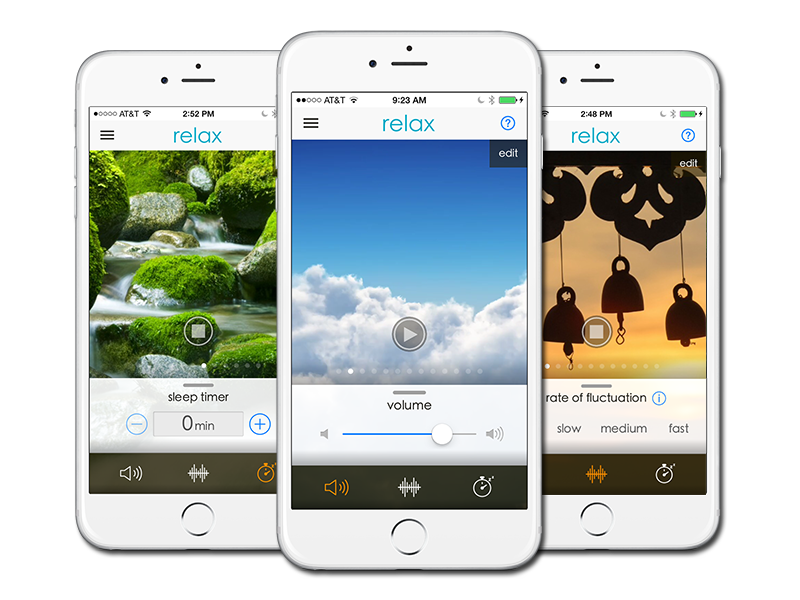
“Tinnitus & Hearing Aid Apps | Starkey” from www.starkey.com and used with no modifications.
Both apps employ freemium models with different pricing approaches. Understanding these differences helps determine which offers better value for your specific needs and budget constraints.
ReSound Relief Pricing Model
ReSound Relief offers a generous free tier that includes basic sound therapy features, simple sound mixing capabilities, and fundamental tracking tools. This free version provides immediate relief options without financial commitment, making it accessible to anyone seeking basic tinnitus sound therapy. The premium subscription ($9.99 monthly or $69.99 annually) unlocks advanced features including the complete sound library, unlimited sound combinations, advanced mixing tools, and comprehensive tracking analytics.
The app occasionally offers promotional pricing for annual subscriptions, reducing the effective monthly cost to around $4.50-5.50 during these promotions. For hearing aid users, ReSound often provides premium access codes through audiologists fitting their devices, potentially eliminating subscription costs entirely. When evaluating value, consider that comparable standalone sound therapy devices typically cost $80-300 with far less customization capability.
Oto Subscription Details
Oto employs a program-based subscription model at $14.99 monthly or $89.99 annually, positioning it at a higher price point than ReSound Relief. The free version provides access to limited educational content and basic exercises but restricts the core 8-week program. The premium subscription unlocks the complete therapeutic program, specialist coaching access, advanced tracking tools, and all habituation exercises.
Oto occasionally offers first-month discounts for new users to experience the full program at reduced cost. Some healthcare providers and employee wellness programs now cover Oto subscriptions, and the company offers hardship discounts for users with financial constraints. When assessing value, consider that traditional tinnitus-focused CBT typically costs $100-200 per session, with programs requiring 8-12 sessions—making Oto’s annual subscription equivalent to roughly one traditional therapy session.
Free vs. Premium Features Comparison
ReSound Relief vs. Oto: Free vs. Premium Features
Feature Category ReSound Relief Free ReSound Relief Premium Oto Free Oto Premium Sound Therapy 10 basic sounds, limited mixing 30+ sounds, unlimited combinations 5 basic sounds, no mixing 15 sounds with limited mixing Therapeutic Content Basic relaxation exercises Full relaxation library, guided sessions Introductory CBT concepts Complete 8-week CBT program Tracking Tools Basic tinnitus journal Advanced analytics, trigger identification Limited progress tracking Comprehensive assessment tools, detailed progress reports Professional Support None Email support None Direct specialist messaging, personalized guidance Educational Content Basic tinnitus information Comprehensive education library Limited educational articles Progressive educational program, expert videos
Who Should Choose ReSound Relief?
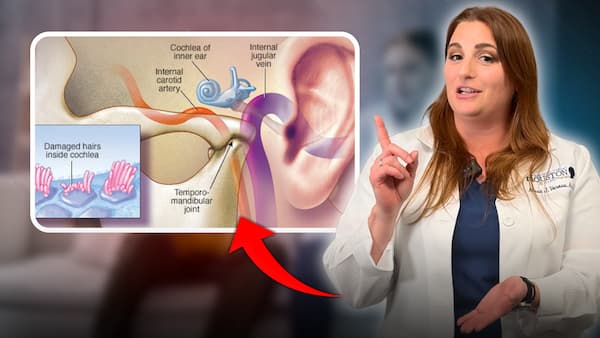
“Understanding Tinnitus: Causes …” from www.houstonent.com and used with no modifications.
ReSound Relief is ideal for individuals seeking immediate tinnitus symptom relief through sound therapy rather than comprehensive psychological retraining. If your tinnitus is primarily bothersome in specific situations like quiet environments or while trying to sleep, ReSound’s customizable soundscapes provide excellent situational relief. The app particularly suits those who find that certain sounds consistently reduce their tinnitus awareness and prefer an approach focused on acoustic management.
Users who value flexibility over structure will appreciate ReSound’s on-demand format, which allows you to use different features as needed rather than following a prescribed program. This makes it well-suited for individuals with unpredictable schedules or those who experience significant day-to-day variation in their tinnitus symptoms. The app also appeals to those who prefer self-directed exploration rather than guided progression, allowing you to discover which sound combinations and relaxation techniques work best through personal experimentation.
Ideal User Profiles
ReSound Relief works particularly well for recently diagnosed tinnitus patients still exploring management options. The app’s accessible approach provides immediate relief strategies while you learn about your condition, making it an excellent starting point in your tinnitus management journey. The sound therapy approach requires minimal time commitment, fitting easily into busy lifestyles without scheduling dedicated “therapy time.”
Individuals with predominantly acoustic tinnitus triggers find ReSound Relief especially effective. If your tinnitus worsens in quiet environments or specific acoustic settings, the app’s sound enrichment tools directly address these environmental factors. The sound masking approach also proves valuable for those using tinnitus management primarily during specific activities like sleeping, working, or studying, as you can create customized soundscapes for each context.
ReSound Relief also serves as an excellent complement to hearing aids, particularly for users of ReSound devices with built-in tinnitus programs. The app integrates with compatible hearing aids to deliver sound therapy directly through your devices, creating a seamless management experience. This integration makes ReSound Relief the natural choice for hearing aid users seeking to enhance their devices’ built-in tinnitus features.
Best Use Case Scenarios
ReSound Relief excels as a nighttime tinnitus management solution, with its customizable soundscapes providing effective sleep assistance without requiring active engagement. The app’s timer features allow sounds to fade gradually as you fall asleep, addressing one of tinnitus’s most common and distressing impacts. Many users report significant improvements in sleep onset and quality even when tinnitus perception during waking hours remains unchanged.
Who Should Choose Oto?

“Tinnitus Habituation: The Secret Method …” from www.joinoto.com and used with no modifications.
Oto represents the ideal choice for individuals seeking comprehensive, long-term tinnitus habituation rather than temporary symptom masking. If your tinnitus causes significant emotional distress, anxiety, or lifestyle limitations, Oto’s structured CBT approach directly addresses these psychological impacts. The app particularly benefits those who have tried sound therapy alone with limited success and are ready to invest in a more intensive habituation program. For more information on how Oto can assist with tinnitus relief, visit Oto Tinnitus Relief.
Users who prefer clear guidance and structured progression will appreciate Oto’s systematic 8-week program format. The daily session approach creates accountability and measurable progress, helping maintain motivation throughout the habituation process. This structure proves especially valuable for those who find self-directed tinnitus management overwhelming or confusing, providing clear next steps rather than requiring you to determine your own therapeutic path.
Ideal User Profiles
Oto serves as an excellent solution for individuals with long-standing tinnitus who have developed significant negative emotional responses to their symptoms. The app’s CBT framework specifically targets the anxiety, frustration, and hypervigilance that often develop around chronic tinnitus, addressing these psychological patterns that frequently maintain tinnitus distress. Users who find themselves constantly monitoring their tinnitus or experiencing fear when symptoms intensify will benefit particularly from Oto’s attention retraining and cognitive restructuring techniques.
Those seeking a science-backed, comprehensive approach appreciate Oto’s foundation in tinnitus-specific research and clinical practice. The app appeals to analytically-minded users who want to understand the neurological mechanisms behind their symptoms and learn evidence-based techniques for addressing them. If you value expertise and professional guidance, Oto’s specialist coaching component provides access to tinnitus professionals without the cost and inconvenience of traditional therapy appointments.
Individuals who have tried multiple management approaches with limited success often find Oto’s systematic program provides breakthrough progress. The app’s multifaceted approach combines elements of CBT, mindfulness, sound therapy, and relaxation training—addressing tinnitus from multiple angles simultaneously. This comprehensive strategy proves particularly effective for complex tinnitus cases that haven’t responded adequately to single-modality approaches like sound therapy or relaxation techniques alone.
Best Use Case Scenarios
Oto functions excellently as a standalone tinnitus management program for those without access to specialized tinnitus clinics. The app’s structured therapy approach and professional coaching provide many elements of clinical tinnitus treatment in an accessible, affordable format. For users in areas with limited tinnitus-specific healthcare resources, Oto offers evidence-based intervention that would otherwise require traveling to specialized centers.
How to Get the Most from Your Chosen App

“Tinnitus Happy Stock Photos – Free …” from www.dreamstime.com and used with no modifications.
Whichever app you select, maximizing its benefits requires consistent engagement and strategic implementation. The most successful users integrate these digital tools into broader tinnitus management strategies, establish regular usage patterns, and customize features to address their specific symptom patterns. Following a few key principles will significantly enhance your results regardless of which platform you choose.
Setting Up for Success
Begin by thoroughly exploring all available features rather than limiting yourself to the most obvious tools. Both apps contain valuable secondary functions that many users overlook—ReSound’s detailed tracking capabilities and Oto’s supplementary exercises often provide unexpected benefits. Complete all onboarding questionnaires thoroughly, as both apps use this information to customize your experience. Invest time upfront in learning the interface and understanding each feature’s purpose, which prevents frustration later when you need relief during tinnitus flare-ups.
Creating an Effective Daily Routine
Consistency proves far more important than duration in digital tinnitus management. Research shows that regular brief sessions produce better outcomes than occasional extended use. Establish a daily 10-15 minute dedicated practice time with your chosen app, preferably at the same time each day to build a sustainable habit. For ReSound Relief users, this might involve sound therapy during a consistent daily activity like commuting or preparing meals. Oto users should prioritize completing the daily prescribed session, ideally during periods of minimal distraction to maximize absorption of therapeutic concepts.
Combining App Use with Other Tinnitus Management Strategies
Digital tools work most effectively as part of a comprehensive tinnitus management approach rather than standalone solutions. Integrate your app usage with other evidence-based strategies including stress management techniques, sleep hygiene practices, and hearing protection when appropriate. Some users benefit from combining both apps—using Oto’s structured program for long-term habituation while employing ReSound Relief for immediate symptom relief during challenging situations. Discuss your digital management approach with healthcare providers who can suggest complementary strategies and help monitor your progress. For more insights, explore progressive tinnitus management and how it works.
Consider environmental factors that influence your tinnitus perception and app effectiveness. Using external speakers rather than headphones for sound therapy can create more immersive environments, particularly for sleep. For CBT exercises, finding consistently quiet spaces improves focus and learning. Bluetooth sleep headphones or pillows with built-in speakers offer comfortable nighttime options for both apps’ sound features without disturbing partners.
The Final Verdict: Making Your Decision

“Three strategies for better decision …” from edexec.co.uk and used with no modifications.
Both ReSound Relief and Oto represent excellent options for digital tinnitus management, with your ideal choice depending on your specific symptoms, preferences, and goals. ReSound Relief offers superior immediate relief through customizable sound therapy with minimal time commitment, making it ideal for situational tinnitus management and those primarily troubled by symptoms in quiet environments. Its flexible, on-demand approach fits easily into varied lifestyles without requiring structured daily practice.
Oto provides a more comprehensive, psychology-focused approach aimed at fundamental habituation rather than temporary symptom masking. Its structured program format, professional coaching, and progressive skill-building create sustainable improvements in how you respond to tinnitus. While requiring greater time commitment and engagement, Oto typically delivers more substantial long-term results, particularly for those with significant emotional distress or lifestyle limitations from their tinnitus.
Many users ultimately benefit from using both apps for different aspects of their tinnitus management. This combined approach leverages ReSound’s excellent sound tools for immediate relief while following Oto’s program for developing lasting habituation skills. If budget allows, this dual strategy provides the most comprehensive digital management solution, addressing both immediate symptoms and underlying psychological responses.
Decision Guide: Which App Matches Your Needs?
Choose ReSound Relief if: Choose Oto if: You find specific sounds consistently provide relief Your tinnitus causes significant anxiety or distress Your tinnitus is primarily bothersome in quiet environments You want long-term habituation rather than temporary relief You prefer flexible, on-demand tools over structured programs You value professional guidance and structured progression You use tinnitus management primarily for sleep or specific activities You’ve tried sound therapy alone with limited success You have ReSound hearing aids with tinnitus features You want to address the psychological impact of tinnitus
Frequently Asked Questions
Throughout our work with tinnitus patients, certain questions consistently arise regarding digital management tools. The following responses address the most common concerns and misconceptions about apps like ReSound Relief and Oto, helping you develop realistic expectations and optimize your experience with these digital solutions.
Understanding these practical aspects of digital tinnitus management can significantly enhance your results and prevent common frustrations. While individual experiences vary considerably, these general principles apply to most users and reflect patterns observed across thousands of tinnitus patients using digital management tools.
Can these apps cure my tinnitus completely?
No, neither ReSound Relief, Oto, nor any other currently available app can completely cure tinnitus. Tinnitus represents a complex audiological and neurological condition that currently has no definitive cure. However, these apps can significantly reduce tinnitus distress and improve quality of life for many users. The goal of digital tinnitus management isn’t elimination of the sound but rather reducing its impact on your daily functioning and emotional well-being.
Success with these apps typically involves changing your relationship with tinnitus rather than eliminating it entirely. Many users report that while they still technically hear their tinnitus, it no longer causes distress or limits their activities. This state—where tinnitus remains audible but loses its negative emotional and attention-grabbing qualities—represents the realistic goal of digital management approaches. Both apps have helped thousands of users achieve this functional improvement even when the acoustic perception itself persists.
How long should I use these apps before seeing results?
Timeline expectations differ substantially between the two apps. ReSound Relief typically provides immediate symptom relief during sound therapy use, with some users reporting reduced tinnitus awareness within minutes of applying appropriate masking sounds. However, carryover benefits after stopping the sound therapy generally develop more gradually, with noticeable improvements in baseline tinnitus distress typically emerging after 3-4 weeks of regular use.
Oto follows a more progressive timeline aligned with its CBT approach. Most users report initial improvements in their emotional response to tinnitus within 2-3 weeks, though significant habituation typically requires completing most or all of the 8-week program. The most substantial and sustainable improvements generally occur between weeks 6-12, as habituation techniques become more automatic with continued practice. Unlike sound therapy’s immediate effects, CBT benefits build cumulatively but tend to persist longer after discontinuing active use.
For both apps, consistent engagement produces faster results than sporadic use. Research indicates that daily short sessions yield better outcomes than occasional extended use, with regularity proving more important than duration. Patience remains essential regardless of which app you choose—neurological habituation represents a gradual process rather than an immediate transformation. For more information, learn about how the ReSound Relief app can help with tinnitus symptoms.
Do I need special headphones for sound therapy with these apps?
No special headphones are required for basic functionality of either app, though audio quality does influence effectiveness, particularly for ReSound Relief’s sound therapy. Standard earbuds or headphones provide sufficient quality for most users, especially when using the apps in relatively quiet environments. For nighttime use, specialized sleep headphones with flat profiles or wireless earbuds designed for side-sleeping offer greater comfort without compromising therapeutic benefit.
For optimal sound therapy results, open-ear designs generally outperform noise-isolating options, as they allow environmental sounds to blend naturally with therapeutic audio. This approach supports healthy auditory integration rather than creating artificial sound isolation. Some users find bone conduction headphones particularly effective for tinnitus management, as they deliver sound without blocking the ear canal—though these remain optional rather than essential equipment.
Can I use both ReSound Relief and Oto together?
Yes, using both apps together creates a complementary approach that many tinnitus specialists actually recommend. The combined strategy leverages each app’s strengths—ReSound Relief’s excellent sound therapy for immediate symptom management and Oto’s structured program for developing long-term habituation skills. This integrated approach addresses both the immediate acoustic aspects of tinnitus and the underlying neurological and psychological responses that maintain tinnitus distress.
When using both apps, consider following Oto’s structured program as your primary therapeutic intervention while employing ReSound Relief situationally for immediate relief during challenging periods or specific activities like sleep. The progressive cognitive skills developed through Oto often enhance ReSound Relief’s effectiveness by reducing the emotional response to tinnitus, creating a synergistic relationship between the two approaches. While this dual strategy requires greater financial investment, it provides the most comprehensive digital management solution for those significantly impacted by their tinnitus.
Will these apps work if I have hearing aids?
Both apps can work effectively alongside hearing aids, though compatibility varies by hearing aid model and features. ReSound Relief offers direct integration with compatible ReSound hearing aids, allowing sound therapy to stream directly through your devices. This integration creates a seamless management experience and enables precise adjustment of the balance between environmental sounds and therapeutic audio. For other hearing aid brands, functionality depends on Bluetooth streaming capabilities—most modern hearing aids support audio streaming, though some entry-level models may not.
Oto’s CBT approach remains fully effective regardless of hearing aid use, as its primary therapeutic mechanisms don’t depend on precise sound delivery. The app’s educational content and exercises can be completed while wearing any hearing aids, and many users find that proper hearing correction actually enhances their ability to implement the program’s habituation techniques effectively. For Oto’s limited sound components, the same streaming considerations apply as with ReSound Relief.
Inform your audiologist about your digital tinnitus management plans, as they can optimize your hearing aid settings to complement these approaches. Many audiologists can program tinnitus-specific settings into your devices that work synergistically with app-based management strategies, enhancing overall effectiveness. This collaborative approach between digital tools and traditional audiology often yields superior outcomes compared to either approach in isolation.
At Oto Health, we’re dedicated to providing comprehensive solutions for tinnitus sufferers through our evidence-based digital therapy program. Our team of audiologists and psychology specialists continuously refines our approach based on the latest tinnitus research to deliver the most effective habituation techniques available. If you’re ready to transform your relationship with tinnitus through proven CBT methods and expert guidance, visit our website to learn more about our personalized 8-week program.
